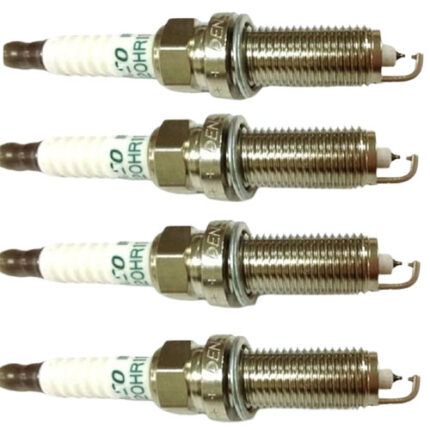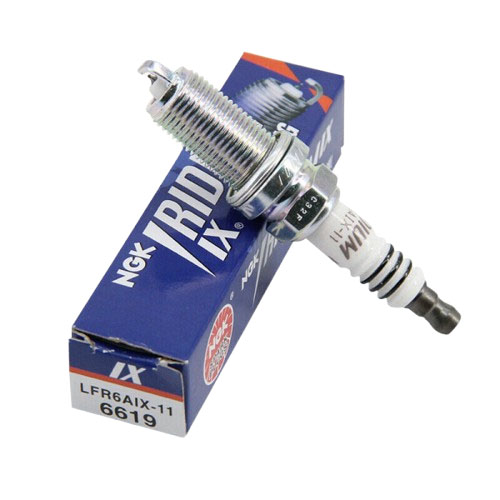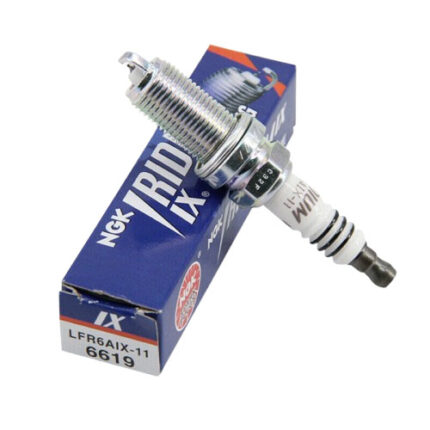-8%
Get NGK Iridium LFR6AIX-11 6619 Spark Plugs in Kenya
The NGK Iridium LFR6AIX-11 (6619) spark plug is a high-performance ignition component engineered for reliability, durability, and efficient combustion. As part of NGK’s premium Iridium IX® series, this plug is designed to deliver stronger sparks, quicker throttle response, and improved fuel efficiency by utilizing advanced materials and precision manufacturing.
This spark plug features a fine-wire iridium center electrode and a tapered ground electrode, both of which contribute to exceptional ignition performance, long service life, and minimal wear. The 11 in the part number represents a 1.1 mm factory-set gap, making it suitable for engines that require that gap specification for proper combustion.
Construction and Materials
-
Iridium Center Electrode
Iridium is a rare, extremely hard metal with a very high melting point (around 2,450°C). The LFR6AIX-11 uses a fine-wire iridium center electrode that enhances ignition by producing a focused, consistent spark. The smaller diameter electrode requires less voltage to fire, improving spark efficiency and combustion. -
Tapered Ground Electrode
The ground electrode is cut in a V-shape (tapered) to reduce quenching and create a larger flame kernel. This design improves the spark’s exposure to the air-fuel mixture, enhancing ignition speed and efficiency. -
Trivalent Metal Plating
The shell is coated with a corrosion- and seizure-resistant trivalent metal plating. This improves durability and eases removal during servicing. -
Insulator Nose
The insulator nose is designed with a longer length to reduce fouling and improve heat dissipation. It also contributes to anti-knock performance and efficient fuel burn. -
Copper Core
The plug includes a copper core inside the electrode, which increases heat conductivity. This helps maintain a stable operating temperature, reducing the chance of overheating or fouling.
Advantages of NGK Iridium LFR6AIX-11 Spark Plugs
-
Improved Ignition Efficiency
The iridium center electrode ensures a stronger and more focused spark. This leads to more reliable combustion, smoother idling, better throttle response, and quicker cold starts. -
Longer Service Life
Thanks to the hardness and heat resistance of iridium, these plugs last significantly longer than traditional copper or nickel plugs. This reduces the need for frequent replacements and lowers maintenance intervals. -
Consistent Performance
Over time, lesser-quality spark plugs degrade and cause misfires, hesitation, or rough running. NGK’s iridium technology ensures consistent spark delivery even under extreme conditions, providing stable performance. -
Fuel Efficiency and Emissions
With better ignition comes more complete combustion, which means less unburned fuel and reduced emissions. This contributes to cleaner engine operation and improved fuel economy. -
High Heat Resistance
These plugs are designed to withstand the elevated temperatures of high-performance or demanding engines without breaking down, making them suitable for heavy-duty and high-revving environments. -
Reduced Fouling
The fine-wire iridium and insulator design resist carbon buildup, oil fouling, and misfires—especially in engines that run rich or are prone to low-speed short trips. -
Better Acceleration and Power Output
The fast ignition and high flame propagation translate to better power delivery and responsiveness during acceleration.
Disadvantages of Worn or Incompatible Spark Plugs
-
Misfires and Poor Ignition
Worn plugs can cause weak or inconsistent sparks, leading to incomplete combustion and frequent misfires, which reduce power and increase emissions. -
Hard Starts and Poor Cold Performance
Bad spark plugs can make it difficult to start the engine, especially in cold weather when the ignition system is under more stress. -
Poor Fuel Economy
Incomplete combustion results in more fuel being used than necessary, which increases fuel consumption and operating costs. -
Increased Emissions
When combustion isn’t efficient, more hydrocarbons and carbon monoxide are released into the exhaust system. -
Rough Idling and Acceleration Hesitation
Inconsistent spark delivery can cause the engine to shake at idle or lag when accelerating, affecting drivability.
Signs That Spark Plugs Need Replacement
-
Rough Idle or Vibrations
If the engine shakes or vibrates at idle, it may be due to worn spark plugs failing to maintain a smooth, consistent burn. -
Increased Fuel Consumption
A sudden drop in fuel efficiency could mean that combustion is no longer optimal, often due to aging spark plugs. -
Engine Misfires or Hesitation
Misfiring cylinders and hesitation under load are common symptoms of spark plugs that are fouled or worn out. -
Difficulty Starting
Weak or inconsistent sparks can make it difficult to start the engine, especially in damp or cold environments. -
Check Engine Light
Modern engine control units (ECUs) can detect misfires and irregular ignition patterns caused by bad spark plugs, triggering a warning light. -
Black or Oil-Fouled Spark Plugs
During inspection, spark plugs that appear blackened, carbon-coated, or oil-fouled typically indicate problems either with the plug itself or engine conditions.
Installation and Maintenance Guidelines
Tools and Materials Required:
-
Ratchet with spark plug socket (usually 5/8″)
-
Spark plug gap gauge (for verification)
-
Torque wrench
-
Anti-seize compound (if recommended)
-
Dielectric grease (optional)
Step-by-Step Installation Process:
-
Ensure Engine is Cool
Always work on a cold engine to avoid thread damage or burns. -
Remove Old Spark Plugs
Disconnect the ignition coil or spark plug wire. Use a ratchet and spark plug socket to carefully remove each old plug. -
Inspect Spark Plug Hole and Threads
Make sure the threads are clean. Use compressed air to blow out debris if necessary. -
Check Gap on New Plug (Optional)
NGK plugs come pre-gapped, but you may want to confirm the 1.1 mm gap using a gap gauge. Do not attempt to adjust fine-wire iridium electrodes unless absolutely necessary, as they can be damaged. -
Apply Anti-Seize (If Recommended)
Some manufacturers recommend applying a small amount of anti-seize compound on the threads. NGK generally does not recommend anti-seize for their plugs, as they are pre-coated with trivalent plating. -
Thread Spark Plug by Hand
Thread the new plug into the cylinder head by hand to avoid cross-threading. Turn it slowly and make sure it goes in smoothly. -
Torque to Specification
Use a torque wrench to tighten the spark plug to the correct torque (usually 18–25 Nm depending on thread size and application). Do not overtighten. -
Reconnect Coil or Plug Wire
Ensure a snug fit to guarantee electrical continuity. -
Repeat for Remaining Cylinders
Replace all spark plugs in sequence, one cylinder at a time.
Follow us on Facebook for more parts.




